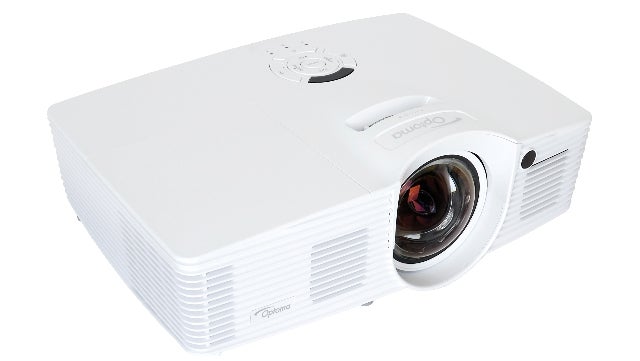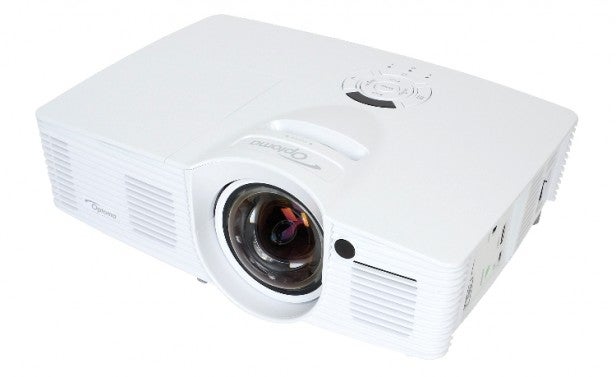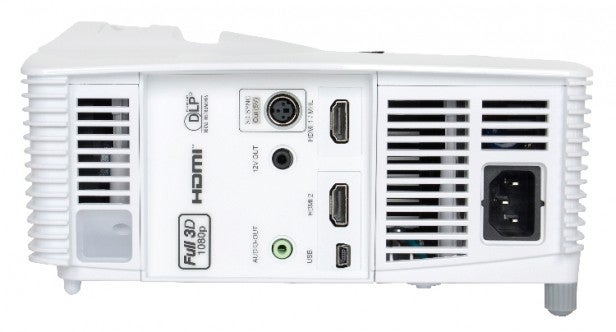Optoma GT1080 Review
Optoma GT1080
Will this gaming projector give you an edge?

Sections
- Page 1 Optoma GT1080 Review
- Page 2 Picture Quality Review
- Page 3 3D, Sound Quality and Verdict Review
Verdict
Pros
- Low input lag
- Plenty of picture customisation
- Decent value
Cons
- Yellow can become rather dominant
- Better black levels can be found elsewhere
- No optical zoom or image shift
Key Specifications
- Review Price: £600.00
- Full HD single-chip projector
- Fast response time for gamers
- Twin HDMI video connections
- 12V trigger port
What is the Optoma GT1080?
The GT1080 is a highly affordable single-chip DLP projector designed primarily for gaming. Its high claimed brightness and built-in audio system make it easy to set up and use – you don’t need a dedicated home cinema ‘cave’ – and its living-room friendliness is underlined by the fact that it’s got an exceptionally short-throw lens. That means it can deliver, for instance, a 100-inch image when it’s positioned just one metre from your screen or wall.
SEE ALSO: Best Games of 2014
Optoma GT1080 – Design and Features
The GT1080 is surprisingly attractive for such a cheap projector. Its white finish looks crisp and right at home in even the chicest of living rooms, while its footprint is diminutive enough to fit on even the smallest of coffee tables. Its gently curved top, raised lens barrel and rounded corners further advance the design’s domestication, with the only minor irritation being the way the grilles to each side let out some light.
SEE ALSO: Xbox One vs PS4
Video connections are limited, with just two HDMIs to cater for your movie and gaming needs. It’s a bit surprising that such a potential ‘games machine’ doesn’t include a VGA port, but we guess most modern gaming laptops are equipped with digital video outputs these days. And obviously HDMI works fine for the current consoles.
There are a couple of pleasant surprises, though: first, there’s a 12V trigger port you could use to fire up a motorised screen. Second, there’s a port for adding a 3D transmitter, since despite its affordability the GT1080 can handle 3D – though please note that neither this 3D transmitter nor any 3D glasses are included with the projector. The transmitter and a single pair of glasses will costs you £90 extra.
One last connection point worth mentioning is the ability of one of the HDMIs to handle the MHL mobile phone link format.
As noted in the introduction, the GT1080’s optics are based on a single-chip DLP system, using a Full HD DarkChip 3 chipset from Texas Instruments. The projector claims a high maximum light output of 2800 Lumens, while claimed contrast is also promising for such a cheap projector at 25,000:1. Though, of course, both these figures should be taken with a hefty pinch of salt given that neither will get close to being attained during real-world viewing conditions.
One other key feature of the GT1080’s optical system is its use of a short-throw lens capable of delivering a 100-inch image from a throw-distance of just one metre. This is potentially a massive help to people trying to accommodate a projector in a normal living environment, as it minimizes the space you need to leave between the projector and the screen – as well as making it easier to keep the projector’s fans and heat away from seating positions.
As usual with Optoma projectors, the GT1080 is much better equipped with picture-calibration features than you might expect for the price. You can manage the three primary and three secondary colours, for instance, as well as choosing from a series of helpfully themed gamma settings – film, video, graphics and standard. There’s also a Dynamic Black system that adjusts the picture’s brightness automatically in response to the image content, while Texas Instruments’ BrilliantColour technology is on hand to boost colour saturations.
Finally you get a selection of colour temperature presets, as well as a series of picture presets to suit different types of content.
SEE ALSO: Best PS4 Games of 2014
It’s worth noting, given the GT1080’s most likely target audience, that its Gaming preset optimises the projector for low response time and high detail.
One final feature to mention is that the GT1080’s built-in audio delivers a claimed 10W of power – but there’s only one speaker, so don’t expect any stereo action. In what we think is a first for a projector, the GT1080 lets you use the projector’s speaker even when you’ve turned its optics off, turning it into a potential speaker for, say, a DAB radio feed from a connected Sky box. Strangely, though, if you opt to leave the projector in its audio playback mode its fans still run a little even if no audio input is incoming. So you could end up burning some unnecessary power if you forget to turn the audio feature off when you’ve finished watching a film or playing a game.
Personally we think this feature should be accompanied by a reminder message when you’re in the process of switching the projector into standby.
SEE ALSO: Best Xbox One Games of 2014
Optoma GT1080 – Setup
Physical setup options with the GT1080 are rather limited. The main shock is that there’s no optical zoom facility; the zoom is fixed. So you have to move the projector forward and backward to get the image size you want – although this is far less of an issue on a projector with a short-throw lens than it would normally be.
Obviously the short-throw nature of the lens means you must actually want such a feature for your room. If you’re wanting a projector to go on a shelf behind your seating position, for instance, or on a hard-to-move coffee table sat at some distance from your screen or wall, then the GT1080 isn’t going to be very helpful.
As well as providing no zoom, the GT1080 provides neither vertical nor horizontal optical shifting. So you’ll almost certainly find that getting the images in the right place on your screen will require a combination of the screw-down legs on the projector’s underside and a provided digital keystone system for getting the edges of your images straight. This is a pity, since digital keystone systems essentially digitally distort the picture, denying you the pixel-for-pixel precision you could otherwise enjoy when mapping Full HD sources to a Full HD display device.
While the GT1080 is rather light on physical setup aids, though, it’s actually better than expected when it comes to calibration aids, as noted earlier.
Our main setup tips – beyond definitely using the Gaming preset for gaming! – are that you set the dynamic contrast feature on, and leave Brilliant Colour set to no higher than two or three to limit noise and keep tones looking balanced and natural. Also, reduce the brightness to its -2 level for movie viewing (based on the Film preset), and tone down the yellow saturation a little when using all but the most vivid presets.

